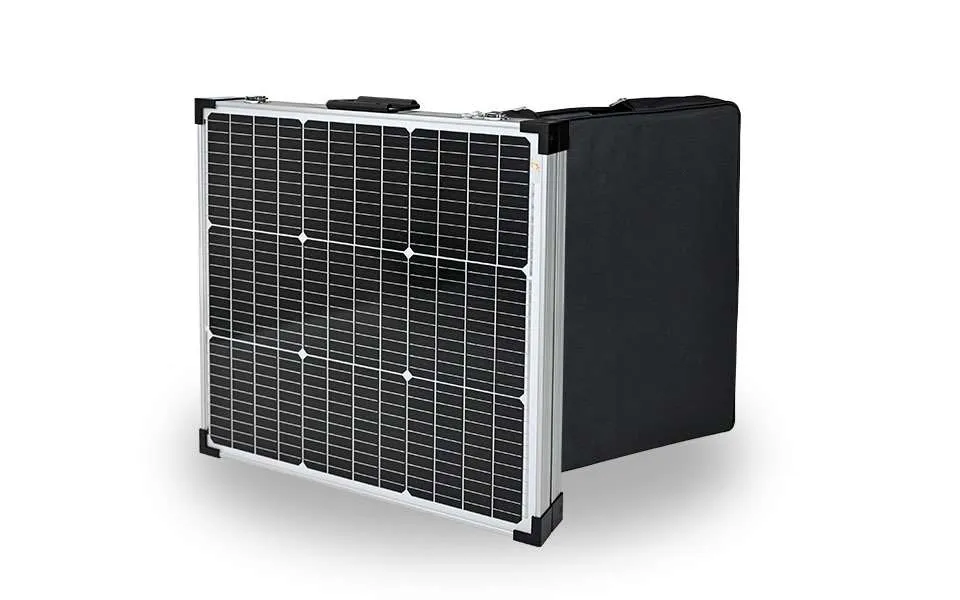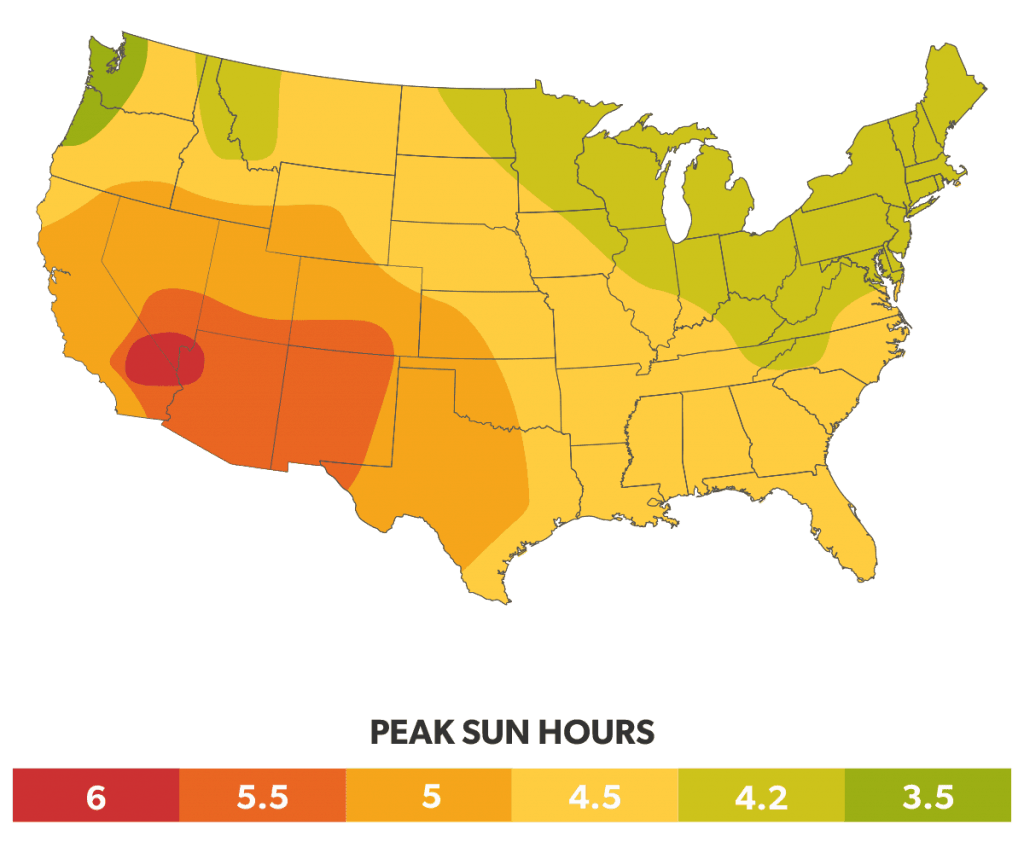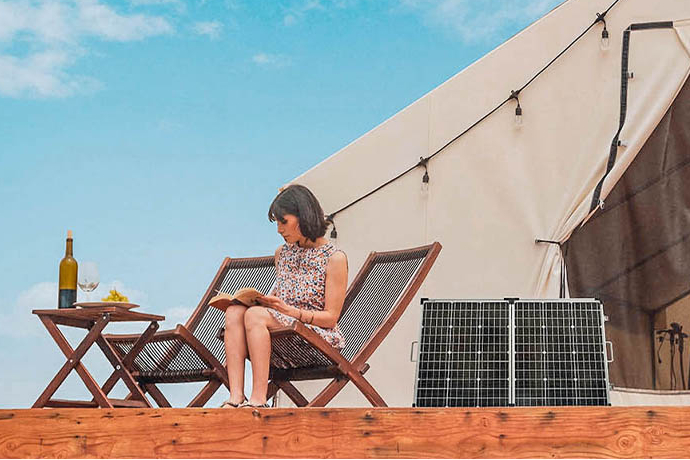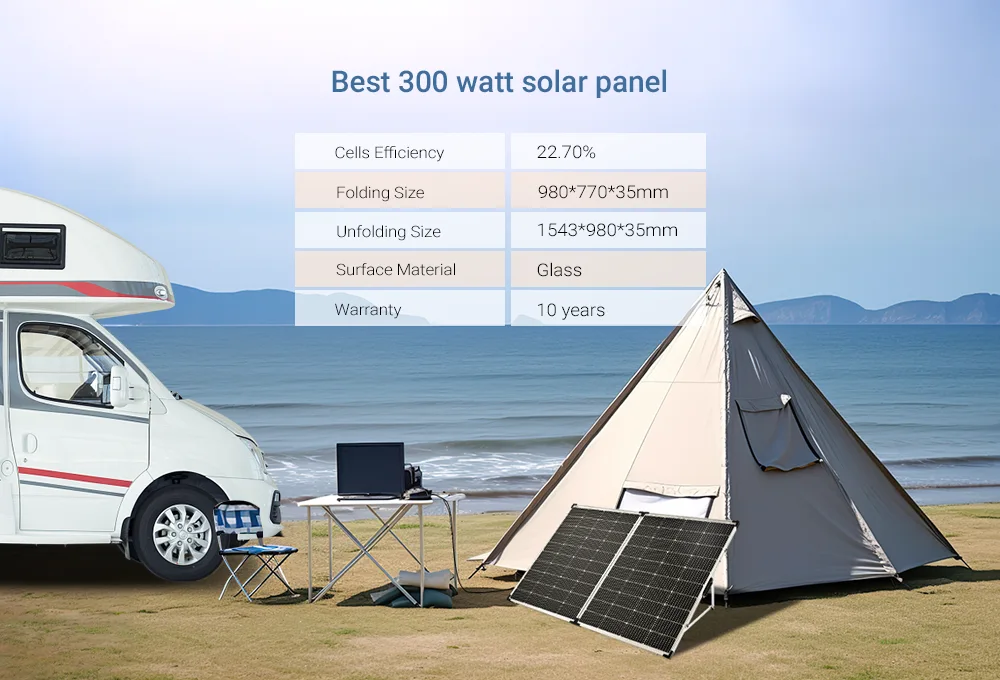This is a complete buying guide to the best 300-watt solar panel.
So if you want to know:
- Power— What can you power with a 300-watt solar panel?
- Output —How much power does a 300-watt solar panel produce?
- Cost—How much does a 300-watt solar panel cost?
- Capacity—How many batteries can a 300-watt solar panel charge?
This complete and informative guide answers your questions and helps you make an informed decision.
How to Choose the Best 300Watt Solar Panel?
There are numerous foldable 300-watt solar panels available on the market. So, how do you pick the best 300-watt solar panel?
Selecting a 300-watt solar panel involves considering various factors to ensure you get a panel that best fits your needs and requirements. Here are some steps to guide you through the selection process:
- Determine your energy needs
- Consider your available space
- Research solar panel brands and types
- Check the efficiency and output
- Compare warranties
- Consider certifications
- Check local regulations and incentives
- Get quotes and compare prices
By carefully considering these factors and seeking expert advice, you can select a 300-watt solar panel or a set of panels that align with your energy requirements and maximize the benefits of solar energy for your home or business.
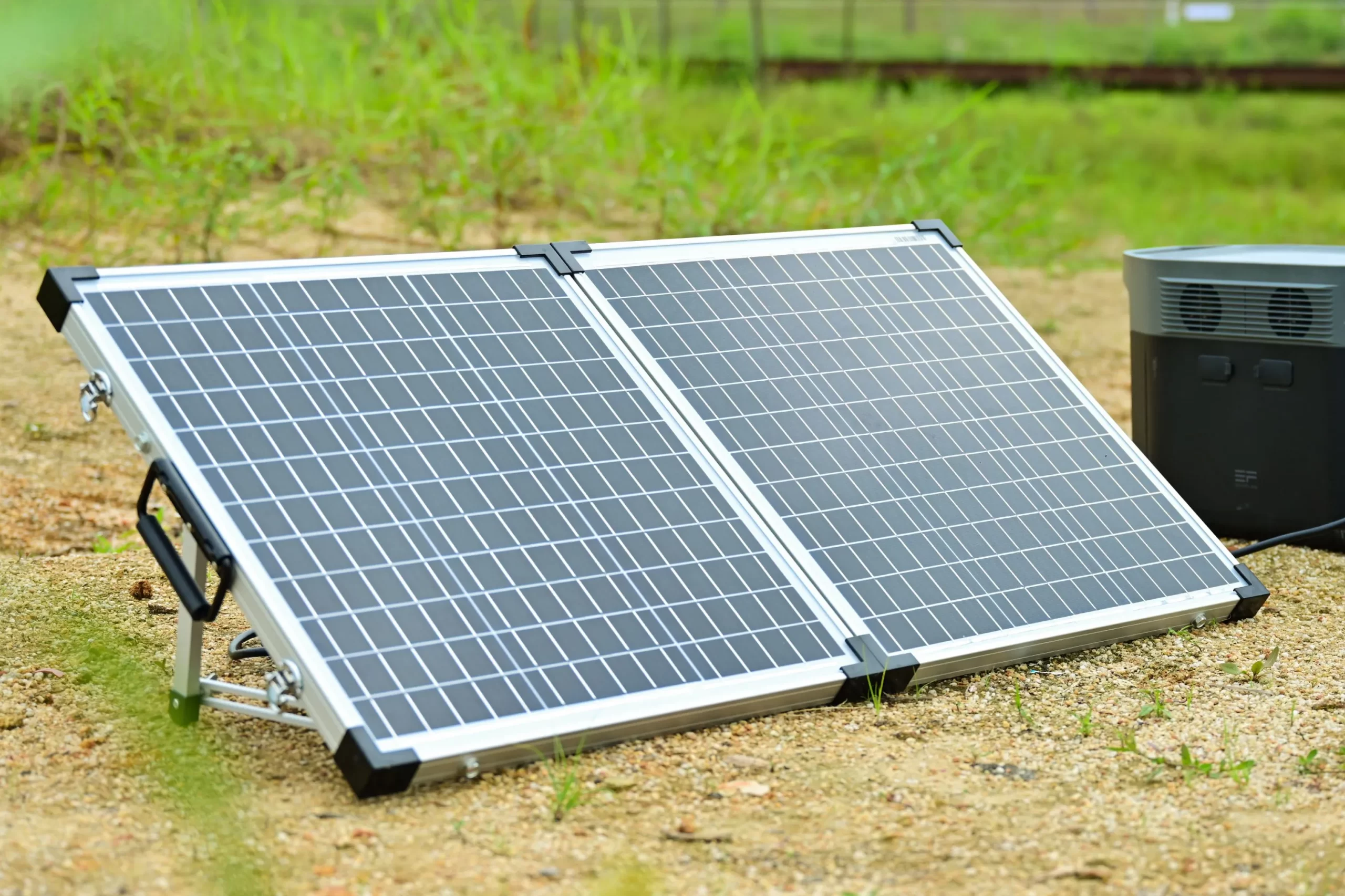
Best 300-Watt Solar Panel
Sungold SGF series 300W solar panels consist of two 150-watt monocrystalline panels. The foldable design allows it to fold like a suitcase, making storage and transport easier. High power output, can be compatible with 1000wh portable power station.
Making the right choice among the many brands and models can be quite confusing, but now I can tell you that the best 300-watt solar panel is the SGF 300W from Sungold.
It can meet basic electricity needs and is suitable for high-power applications such as camping, RVs, off-grid homes, and unexpected power outages.
Whether you are purchasing a solar module for home use, looking for solar panels for mobile homes, RVs, camping, or a reliable solar solution for your business, it is perfect for your specific application.
How Much Power Can A 300W Solar Panel Produce?
How much power does a 300-watt solar panel produce? A 300-watt solar panel can produce up to 300 watts of power under ideal conditions.
The amount of power generated by a solar panel depends on a variety of factors such as location, orientation, tilt, shade, and weather conditions.
The 0.8 factor accounts for the losses due to the inverter, wiring, and other inefficiencies.
When the peak sun hours is 4 hours, to estimate the energy output of a 300w panel, you can use the following formula:
Solar panel output = (Solar panel rated wattage × Peak sun hours) × 0.8
300w×4h×0.8=0.96kwh
So, a 300-watt solar panel can generate about o.96kwh of energy per day under average conditions.
The amount of power generated per year can be calculated by multiplying the amount of power generated per day (0.96 kWh) by the number of days in a year (365). This results in an annual energy production of approximately 350.4kWh.
What Can A 300 Watt Solar Panel Run?
What can a 300-watt solar panel run?
A 300-watt solar panel can run various appliances and devices that have a lower power consumption, run a laptop for about 4 hours, a blender for about 40 minutes, or a small fridge for about 2 hours during peak sun hours.
The exact number and type of appliances that can be run depends on factors such as the battery capacity, the inverter efficiency, the peak sun hours, and the power rating of each appliance.
Some appliances that can be run by a 300-watt solar panel are:
- A ceiling fan (60 watts)
- A dehumidifier (240 watts)
- A slow cooker (160 watts)
- A TV (230 watts)
- A laptop (50 watts)
- A LED light (10 watts)
Solar panel output is slightly lower than the appliance energy consumption, so you would need a battery to store some excess energy from the panel or reduce the hours of use of the appliances. Alternatively, you could add another solar panel to increase the output.
Can A 300W Solar Panel Run A Fridge?
Yes, a 300w solar panel can run a fridge.
Still, it depends on the specific power requirements of the refrigerator and other factors such as the location, climate, and availability of sunlight.
Most refrigerators typically use between 300 and 600 watts of electricity when running. If your fridge falls within this power range and you have a 300-watt solar panel, it may be able to provide enough electricity to power the fridge under certain conditions.
However, it’s essential to consider that solar panels don’t produce their maximum rated output all the time. The actual power output of a solar panel will vary throughout the day based on factors such as sunlight intensity, shading, and panel orientation. Additionally, solar panels don’t generate power during the night.
To ensure your fridge receives a consistent power supply, you would need to use a battery storage system to store excess energy generated during sunny periods. The battery can then power the fridge during the night or when the solar panel output is insufficient.
Can A 300 Watt Solar Panel Charge A 12-volt Battery?
Yes, a 300-watt solar panel can charge a 12-volt battery.
You need a solar panel controller that supports both voltages. Most controllers on the market can handle 12-volt batteries, but the key is to make sure the controller can handle the current generated by the solar panel.
In this case, you must handle 25 amps of current (300 watts/12 volts = 25 amps).
To be on the safe side, it is recommended to choose a controller with a slightly higher current rating, such as a 30 amp controller.
There are two main types of controllers: PWM (Pulse Width Modulation) and MPPT (Maximum Power Point Tracking).
PWM controllers are more affordable, while MPPT controllers are slightly more expensive but offer better performance, especially in low-light conditions. If you plan to use solar panels extensively or need more power, investing in an MPPT controller may be a wise decision.
300-watt solar panels can indeed charge 12-volt batteries, but it’s important to choose a compatible solar panel controller with the proper amperage rating for a safe and efficient charging process. If possible, consider investing in an MPPT controller for better performance, especially in challenging lighting conditions or demanding applications.
How Many 300W Solar Panels Do I Need?
You must first decide what type of system you want before purchasing a 300W solar panel kit.
- For Home:
How many 300-watt solar panels are required? The answer to your question depends on several factors, such as your annual electricity usage, your geographic location, and the solar panel specifications. According to the U.S. Energy Information Administration (EIA), the average American household uses 10,791 kWh of electricity per year. If you want to offset 100% of your electricity bill with solar panels, you need to calculate how many solar panels you need based on the following formula:
solar panels needed = electricity consumption / (365 × solar hours in a day × panel power output)
where electricity consumption is the yearly amount in kWh, solar hours in a day is the average number of peak sunlight hours in your location, and panel power output is the wattage of each solar panel.
For example, if you live in California, where the average solar hours in a day is 5.6, and you use 300W solar panels, the formula becomes:
solar panels needed = 10,791 / (365 × 5.6 × 300) ≈ 17
So, you need about 17 solar panels to fully power your home with solar energy.
However, this number may vary depending on your actual electricity usage, roof size, shading, orientation, and other factors.
- For RV:
The number of 300-watt solar panels you need for your RV depends on the size and power of the inverter, the appliances you want to run, and the battery capacity. You’ll need at least 12 300-watt solar panels and a large battery bank to power a 3000-watt inverter. To power small appliances such as LED lights, laptops, and TVs.
- For Camping:
For simple outdoor camping, you just need to run some of the small devices with the 300w solar panels, used with portable power station, a single 300w solar panel can provide enough power supply and replenishment for camping.
What Size Cable for A 300 Watt Solar Panel?
To determine the size of the cable for a 300W solar panel, you need to consider the Amps and voltage involved in the system.
–Calculate Amps: Start by determining the maximum current (Amps) that the 300-watt solar panel will generate. Divide the power output (300W) by the system voltage (e.g., 12V or 24V) to get the current.
For example, if it’s a 12V system:
300W / 12V = 25 Amps.
–Select the Wire Size: After calculating the Amps, refer to an “ampacity chart” to find the appropriate wire size that can handle the current without significant voltage drop or heating issues. Consider the various connections in your solar setup, such as panel to charge controller, charge controller to battery, and battery to inverter.
–Oversizing the Wire: If you’re unsure about the exact wire size to use, it’s generally safer to choose a slightly larger wire gauge than the minimum required by the ampacity chart. A larger wire will have lower resistance and can handle more current with less voltage drop.
–Consider Voltage: Higher voltage systems typically experience less voltage drop over longer cable runs, so if you have a choice, consider using higher voltage setups ( 24V or 48V) for longer distances.
–Insulation and Conduit: Ensure that the wire you use has proper insulation suitable for high rooftop temperatures and the high voltage that solar panels can produce. For added safety, protect the wires in a grounded metal conduit to prevent any electrical hazards.
–MPPT Charge Controller: If you’re using a 12V 100Ah battery with a 300W solar panel, a proper MPPT charge controller for 300W solar panels is recommended to efficiently charge the battery and make the most of the available solar energy.
Conclusion
Buy a 300W solar panel for your RV to have a dependable and eco-friendly power supply while traveling. By considering factors such as your power requirements, roof space, efficiency, mounting options, charge controller, wiring, durability, and budget, you can make an informed decision and select the right solar panel to meet your energy needs. A well-chosen solar panel will not only enhance your RV adventures but also contribute to a greener future.
Sungold Solar is happy to recommend our star products flexible solar panels 100w and portable 400w solar panels, welcome to contact us for more information.


